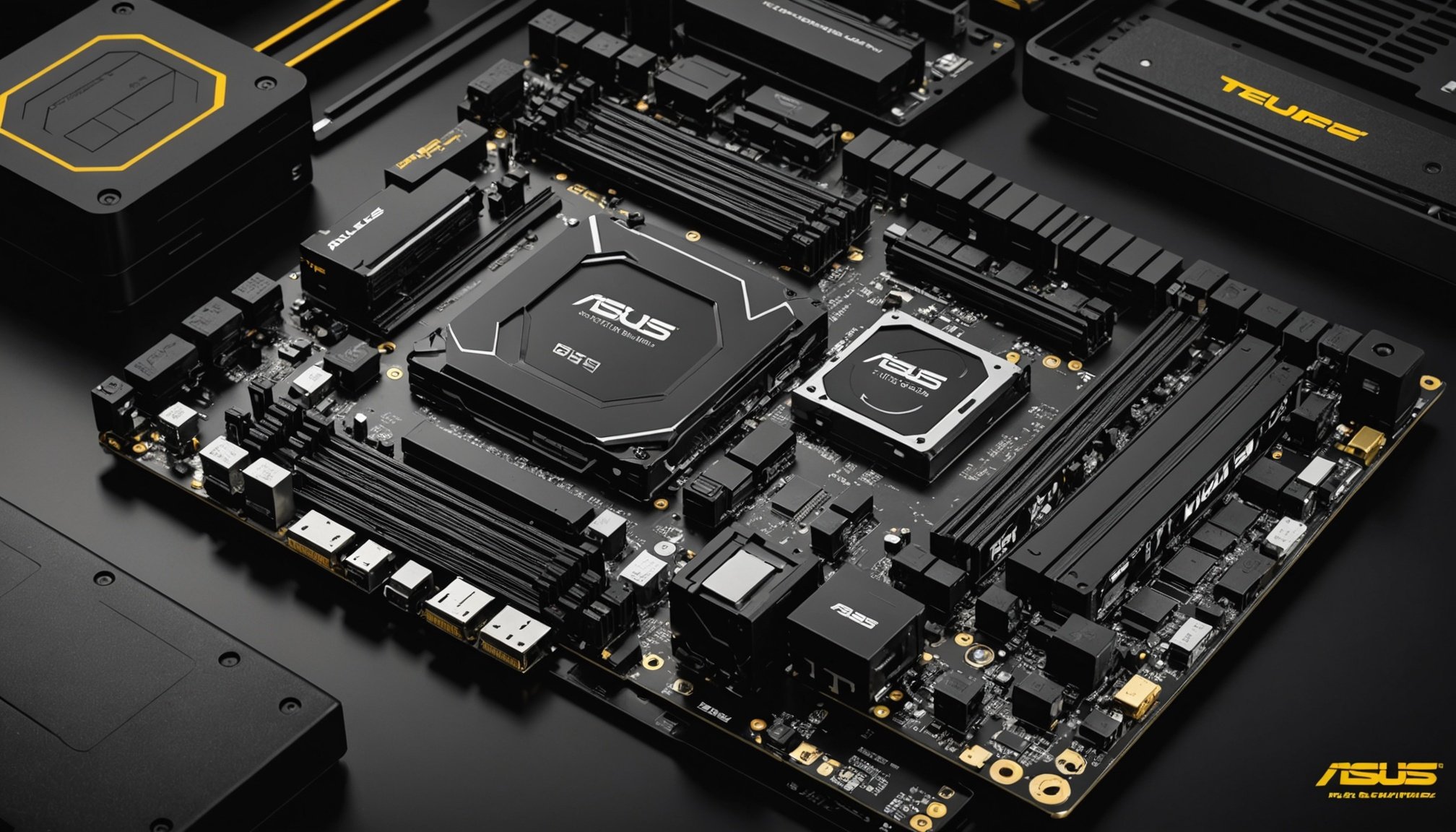Unlocking Peak Performance: Key NVMe SSD Configuration Strategies for Your ASUS TUF Gaming X570-Plus
When it comes to building a high-performance gaming PC, the choice of motherboard and storage solutions can make all the difference. The ASUS TUF Gaming X570-Plus is a powerhouse of a motherboard, designed to unleash the full potential of your system, especially when paired with NVMe SSDs. Here’s a comprehensive guide on how to configure your NVMe SSDs to achieve peak performance with your ASUS TUF Gaming X570-Plus.
Understanding NVMe SSDs and the ASUS TUF Gaming X570-Plus
To start, let’s delve into the world of NVMe SSDs and the ASUS TUF Gaming X570-Plus motherboard.
Additional reading : Ultimate guide to configuring and enhancing your thunderbolt 3 dock with a dell xps 13 for superior connectivity
NVMe SSDs are a game-changer in data storage, offering dramatically increased read and write speeds compared to traditional SSDs. NVMe stands for Non-Volatile Memory Express, a protocol designed to exploit the speed of flash storage. This results in reduced loading times and enhanced system responsiveness, making them ideal for gaming enthusiasts and productivity-oriented users[1].
The ASUS TUF Gaming X570-Plus motherboard is engineered to maximize the performance of these high-speed storage solutions. With dedicated slots for NVMe SSDs and support for PCIe 4.0, this motherboard ensures faster data transfers and optimal system operation. The X570 chipset, combined with the motherboard’s robust power delivery and comprehensive cooling options, makes it an excellent foundation for your next high-core-count AMD battle rig[3][4].
Have you seen this : Comprehensive Guide to Boosting Your Lenovo ThinkStation P620 Performance with Additional RAM: A Step-by-Step Setup Manual
BIOS Configuration for Optimal SSD Performance
Configuring the BIOS correctly is crucial to unlocking the full potential of your NVMe SSDs.
Accessing the BIOS
To access the BIOS on your ASUS TUF Gaming X570-Plus, press the “Del” key immediately when the system starts. If this doesn’t work, try the “F2” key as an alternative entry command[1].
Key Configuration Options
Once in the BIOS, you need to ensure the following settings are configured correctly:
- M.2 Configuration: Locate the M.2 configuration settings to ensure proper activation of your SSD slot. This is critical for maximizing data transfer speeds, especially if you are using NVMe drives.
- SATA Mode: Switch the SATA mode to AHCI for better compatibility and performance. AHCI (Advanced Host Controller Interface) allows for hot-swapping and native command queuing, which can significantly improve SSD performance[1].
Recommended SSD Models for ASUS TUF Gaming X570-Plus
Choosing the right NVMe SSD is essential for optimal performance. Here are some top recommendations that balance compatibility and high performance:
- Samsung 970 EVO Plus: Known for its superior speed and reliability, this SSD offers read speeds up to 3,500 MB/s and write speeds of 3,300 MB/s. It is a reliable choice for gaming and intensive tasks[1].
- WD Black SN750: This model delivers impressive speed with read and write rates surpassing 3,000 MB/s. It offers a competitive price-to-performance ratio and is designed specifically for gamers and creatives[1].
- Crucial P5 Plus: For those on a budget, the Crucial P5 Plus offers read speeds up to 6,600 MB/s, ensuring excellent value and compatibility with the ASUS TUF Gaming X570-Plus[1].
Utilizing RAID Setups for Enhanced Performance
For those seeking even higher performance, configuring SSDs in a RAID setup can be highly beneficial.
RAID 0 for Maximum Speed
RAID 0 (Redundant Array of Independent Disks) splits data into pieces and writes them across multiple SSDs, significantly increasing speed. However, it does not provide redundancy, so data safety is compromised. Here’s how you can set it up:
- Setup: Configure RAID 0 in your BIOS or through your operating system. Ensure that all SSDs in the RAID array are identical for optimal performance.
- Considerations: While RAID 0 offers maximum speed, it does not provide any data redundancy. If data safety is a concern, consider RAID 1, which mirrors data across drives but does not offer the same speed boost[1].
Heat Management Strategies
Efficient heat management is crucial for sustaining SSD performance, especially under heavy loads.
Cooling Solutions
- Heatsinks: Implement heatsinks or fans, particularly if your setup supports it. The ASUS TUF Gaming X570-Plus features an actively cooled heatsink to prevent throttling during sustained transfers[3][4].
- Air Ducts and Fans: The custom low-noise fan with a high-durability bearing and specially-designed air ducts help generate static pressure and concentrate airflow over the fins, optimizing heat dissipation[3].
Power Design and Cooling Options
The power design and cooling options of the ASUS TUF Gaming X570-Plus are designed to support high-performance components.
CPU VRM
The motherboard features a 12+2 phase VRM with Dr. MOS power stages, combining high-side and low-side MOSFETs and drivers into a single package. This delivers the power and efficiency required by AMD’s latest processors[3][4].
PCB Design
The 6-layer PCB design shifts heat away from critical components, providing more headroom to push your CPUs beyond stock speeds. This multi-layer design ensures better heat dissipation and stability[3][4].
Additional Features and Connectivity
The ASUS TUF Gaming X570-Plus is not just about raw performance; it also offers a wealth of features and connectivity options.
USB and LAN Connectivity
- USB Ports: The motherboard includes multiple USB 3.2 Gen 2 and Gen 1 ports, as well as a USB 3.2 Gen 2×2 Type-C header, providing ample connectivity for peripherals[3][4].
- LAN and Wi-Fi: With Realtek L8200A LAN and Intel Wi-Fi 6, you get robust and reliable network connectivity options[3][4].
Audio and RGB Lighting
- Audio: The motherboard features dedicated audio PCB layers, premium Japanese audio capacitors, and exclusive DTS Custom for gaming headsets, ensuring high-quality audio output[3][4].
- RGB Lighting: With Aura Sync and addressable Gen 2 RGB headers, you can customize your system’s lighting to match your gaming setup[3][4].
Practical Insights and Actionable Advice
Here are some practical tips to help you get the most out of your ASUS TUF Gaming X570-Plus and NVMe SSDs:
BIOS Updates
- Regularly update your BIOS to ensure you have the latest features and performance optimizations.
- Use the BIOS flashback feature to update the BIOS even if the CPU is not supported by the current version.
SSD Placement
- Place your NVMe SSDs in the M.2 slots that support PCIe 4.0 for maximum speed.
- Avoid using the third M.2 slot if it shares lanes with other components, as it may reduce the speed to x2 Gen 4[2].
Cooling Maintenance
- Regularly clean dust from the heatsinks and fans to ensure optimal cooling performance.
- Monitor temperatures to prevent thermal throttling.
Detailed Comparison of Recommended SSDs
Here is a detailed comparison of the recommended SSDs for your ASUS TUF Gaming X570-Plus:
| SSD Model | Read Speed | Write Speed | Compatibility | Price Range |
|---|---|---|---|---|
| Samsung 970 EVO Plus | Up to 3,500 MB/s | Up to 3,300 MB/s | PCIe 3.0 x4 | High-end |
| WD Black SN750 | Up to 3,000 MB/s | Up to 3,000 MB/s | PCIe 3.0 x4 | Mid-range to High-end |
| Crucial P5 Plus | Up to 6,600 MB/s | Up to 5,000 MB/s | PCIe 4.0 x4 | Mid-range |
Quotes and Expert Opinions
- “The ASUS TUF Gaming X570-Plus is a solid choice for those looking to build a high-performance gaming PC. Its support for PCIe 4.0 and robust power delivery make it an excellent foundation for AMD’s latest CPUs,” says a PC Gamer expert[2].
- “Configuring the BIOS correctly is key to unlocking the full potential of your NVMe SSDs. Ensure that the M.2 configuration and SATA mode are set correctly to avoid any bottlenecks,” advises an ASUS technical support specialist[1].
Unlocking peak performance with your ASUS TUF Gaming X570-Plus and NVMe SSDs requires careful configuration and the right hardware choices. By following the BIOS configuration tips, selecting the right SSD models, utilizing RAID setups, and managing heat efficiently, you can ensure your system operates at its best.
Whether you are a gaming enthusiast or a productivity-oriented user, the synergy between the ASUS TUF Gaming X570-Plus and high-performance NVMe SSDs will provide you with the speed and responsiveness you need to take your computing experience to the next level. So, dive in, configure your system with precision, and enjoy the ultimate gaming and productivity experience.











